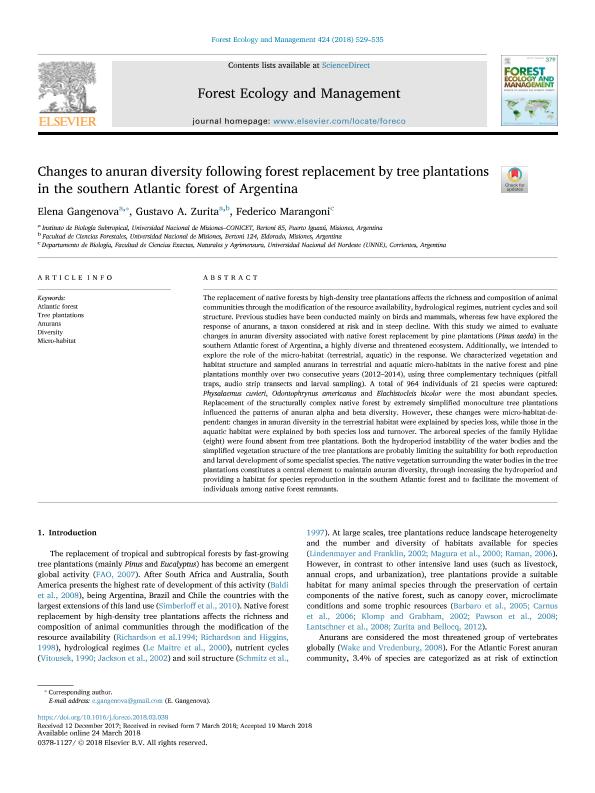Artículo
Changes to anuran diversity following forest replacement by tree plantations in the southern Atlantic forest of Argentina
Fecha de publicación:
09/2018
Editorial:
Elsevier Science
Revista:
Forest Ecology and Management
ISSN:
0378-1127
Idioma:
Inglés
Tipo de recurso:
Artículo publicado
Clasificación temática:
Resumen
The replacement of native forests by high-density tree plantations affects the richness and composition of animal communities through the modification of the resource availability, hydrological regimes, nutrient cycles and soil structure. Previous studies have been conducted mainly on birds and mammals, whereas few have explored the response of anurans, a taxon considered at risk and in steep decline. With this study we aimed to evaluate changes in anuran diversity associated with native forest replacement by pine plantations (Pinus taeda) in the southern Atlantic forest of Argentina, a highly diverse and threatened ecosystem. Additionally, we intended to explore the role of the micro-habitat (terrestrial, aquatic) in the response. We characterized vegetation and habitat structure and sampled anurans in terrestrial and aquatic micro-habitats in the native forest and pine plantations monthly over two consecutive years (2012–2014), using three complementary techniques (pitfall traps, audio strip transects and larval sampling). A total of 964 individuals of 21 species were captured: Physalaemus cuvieri, Odontophrynus americanus and Elachistocleis bicolor were the most abundant species. Replacement of the structurally complex native forest by extremely simplified monoculture tree plantations influenced the patterns of anuran alpha and beta diversity. However, these changes were micro-habitat-dependent: changes in anuran diversity in the terrestrial habitat were explained by species loss, while those in the aquatic habitat were explained by both species loss and turnover. The arboreal species of the family Hylidae (eight) were found absent from tree plantations. Both the hydroperiod instability of the water bodies and the simplified vegetation structure of the tree plantations are probably limiting the suitability for both reproduction and larval development of some specialist species. The native vegetation surrounding the water bodies in the tree plantations constitutes a central element to maintain anuran diversity, through increasing the hydroperiod and providing a habitat for species reproduction in the southern Atlantic forest and to facilitate the movement of individuals among native forest remnants.
Palabras clave:
ANURANS
,
ATLANTIC FOREST
,
DIVERSITY
,
MICRO-HABITAT
,
TREE PLANTATIONS
Archivos asociados
Licencia
Identificadores
Colecciones
Articulos(CCT - NORDESTE)
Articulos de CTRO.CIENTIFICO TECNOL.CONICET - NORDESTE
Articulos de CTRO.CIENTIFICO TECNOL.CONICET - NORDESTE
Articulos(IBS)
Articulos de INSTITUTO DE BIOLOGIA SUBTROPICAL
Articulos de INSTITUTO DE BIOLOGIA SUBTROPICAL
Citación
Gangenova, Elena; Zurita, Gustavo Andres; Marangoni, Federico; Changes to anuran diversity following forest replacement by tree plantations in the southern Atlantic forest of Argentina; Elsevier Science; Forest Ecology and Management; 424; 9-2018; 529-535
Compartir
Altmétricas




